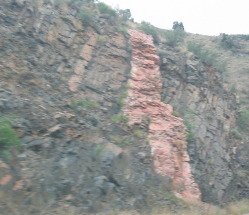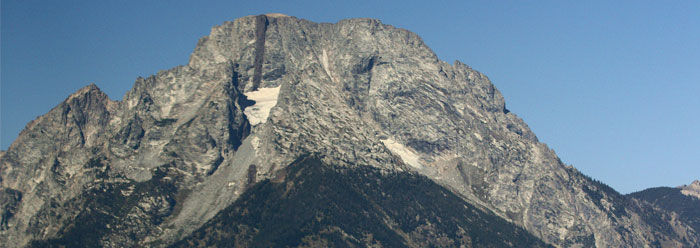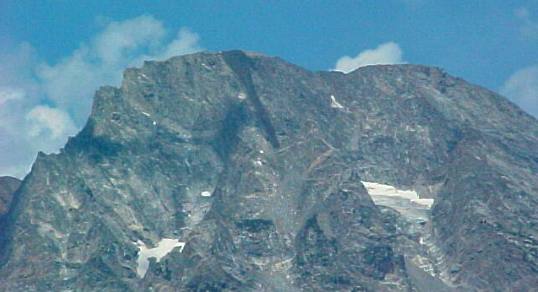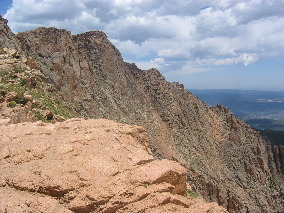Dike
A dike is an intrusion of molten rock into an opening or crack in pre-existing layers or bodies of rock. Thus the material composition of a dike is always younger than the rocks that contain it. The liquid rock in a dike cools underground thus becoming part of the formation.
Intrusion of igneous rock created this dike & sill protruding through much older sandstone
What defines a dike is that it cuts across the bedding planes of the rock it intrudes. When an intrusion cuts along the bedding planes, it is called a sill. In a simple set of flat-lying rock beds, dikes are vertical and sills are horizontal. We were in Grants, New Mexico and taking the road to the summit of Mt Taylor. Not far out of Grants we passed this fantastic piece of geology. Now mind you I am no geologist but we have been visually inspecting western geology for 6-years now and we have seen this often enough to know that it is an intrusion of molten lava (the dark rock) while deep in the earth, into a crack in overlying rock, in this case sandstone (the light colored rock). This exposure is as good at showing this as any example in a geology book. You can see the dike that intruded from the center of the earth as molten lava in the right center of this picture. When it intruded into the sandstone other layers of sandstone were still between this intrusion and the surface. None the less this dike intruded into a vertical crack in the sandstone then began to spread out horizontally in a horizontal crack creating a sill. The horizontal portion of this intrusion is called a sill. Thus the vertical part of the intrusion is a dike while the horizontal portion is a sill. Can you distinguish between the dike and the sill in this classic intrusion?
The overlying sandstone has eroded away leaving only this dike and sill. The very hard igneous rock that spread out horizontally in that crack is called a sill. It now serves as a cap rock protecting the much softer sandstone under it.
Intrusion of igneous rock created this dike protruding through much older sandstone
This example of a dike and intrusion is so awesome I just had to show you a close-up so you can better see the vertical dike that intruded in the vertical crack in the light colored sandstone. An intrusion is created when molten (igneous) rock intrudes into older rock (in this case sedimentary sandstone) then hardens. Keep in mind that this vertical dike as well as the horizontal parts (sill) cooled while underground, resulting in igneous rock that is different from molten rock that is exposed to the atmosphere while it is still molten and cools rapidly. The time spent cooling results in different types of igneous rock.
Igneous intrusions or dikes along the Salmon River in Stanley, Idaho
We saw these dikes on the side of the Salmon River in Stanley, Idaho. What is visible here is what remains after erosion has carried away the much softer sedimentary rocks that this much harder igneous intruded into. Of course the molten/liquid igneous rock was forcing its way to the surface from deep within the earth and making its way into cracks in the sedimentary rocks. What we see now is where that hard igneous rock actually cooled in the cracks deep within the earth.
If you are interested in locating these intrusions they are along the Salmon River just outside the town of Stanley, Idaho in what is known as Lower Stanley. You will not miss these impressive intrusions they are prominently displayed on the hill behind some rafting businesses.
Dike exposed in Hells Canyon, Idaho
As the softer rock erodes it exposes this extremely hard igneous rock that had intruded into a crack in the overlying rock while still deep within the crust of the earth. We are now seeing the dike (that intrusion) after the softer overburden has eroded away.
Dikes of basalt near John Day, Oregon
These hoodoos were seen in eastern Oregon near the town of John Day.
This looks like it was formed underground as an intrusion of molten rock that forced its way into cracks in the overlying crust. Now the overlying rock has eroded away leaving this much harder igneous rock that intruded into the cracks of the sedimentary layers.
Dike of igneous rock near Avon, Montana
We spotted this dike of igneous rock near Avon, Montana. It is so strange looking but is no doubt an intrusion of igneous rock. You can see this dike on US-12 near Avon, Montana. Just look for the strange "fin". This rock is obviously harder than the surrounding rock as it has not eroded away like the softer rock has. It must have been intruded into the limestone by molten rock from deep in the earth.
Intrusion of ingneous rock or dike
This is another picture of that strange formation. It has to be an intrusion of igneous rock into a crack in the overlying sedimentary layers.
Near the McDonald Observatory in west Texas near Ft Davis
Classic example of a dike created when molten rock intruded into and shouldered aside the overlying rock.
The dark streak on Mt Moran in Grand Teton National Park is a classic dike
In addition to the dike visible in this picture you can also see a cirque. The cirque is that bowl of snow or mini glacier at the bottom of the dike.
Another view of the dike on Mt Moran in Grand Teton National Park
Note the cirque to the right. The cirque is that mini-glacier. The dike on top of Mt Moran in Grand Teton National Park is probably one of the more recognizable dikes anywhere.
Dike visible on Pikes Peak in Colorado
And a hogback of what looks to be igneous rock injected into long crack in an overlying rock formation. That overlying rock formation is long gone, eroded away over the millions of years since this dike of igneous rock was thrust upward.
More Geology PagesSome Miscellaneous Subjects ** Our Cute Signs
Mike & Joyce Hendrix
Mike & Joyce Hendrix who we are We hope you liked this page. If you do you might be interested in some of our other Travel Adventures: Mike & Joyce Hendrix's home page Travel Adventures by Year ** Travel Adventures by State ** Plants ** Marine-Boats ** Geology ** Exciting Drives ** Cute Signs ** RV Subjects ** Miscellaneous Subjects
We would love to hear from you......just put "info" in the place of "FAKE" in this address: FAKE@travellogs.us Until next time remember how good life is.
|
|
||

|
|||
|
|
|||
|

|
|||
|
|




